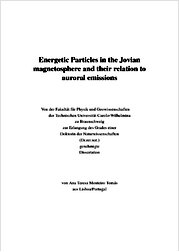Energetic particles in the Jovian magnetosphere and their relation to auroral emissions
Tomás, Ana Teresa Monteiro
Univ. Zugl.: Braunschweig
Monografie
Verlagsversion
Englisch
Tomás, Ana Teresa Monteiro, 2005: Energetic particles in the Jovian magnetosphere and their relation to auroral emissions. Univ. Zugl.: Braunschweig, 123 S., DOI: 10.23689/fidgeo-147.
 |
Dokument öffnen: |
This thesis discusses the relation between the energetic particle characteristics measured by Galileo in the inner to middle Jovian magnetosphere, and the auroral emissions observed by the Hubble Space Telescope. The thesis determines particle and field properties in the transition region between the dipolar and the current sheet region of the Jovian magnetosphere. The prime focus of the work is on the analysis and interpretation of the electron pitch angle distribution. A discussion is presented on how adiabatic processes and particle diffusion processes, such as pitch angle diffusion by whistler waves, can explain the observed distributions in the equatorial plane and how they can be related to the Jovian auroral emissions. Furthermore, the importance of these mechanisms in the framework of global plasma transport models is discussed. The introductory chapter briefly describes the fundamental features of the Jovian magnetosphere, with specific emphasis on phenomena which have no equivalence in the Earths̉ magnetosphere. The most outsanding factors that make the Jovian magnetosphere a particular case are the presence of the moon Io and the fast rotation of the planet. Io is the most important source of plasma in the Jovian magnetosphere releasing 1 ton/s of sulphur and oxygen ions, and therefore clearly conditions the plasma transport, acceleration and diffusion processes. Thus in contrast to the solar wind driven terrestrial magnetosphere, the magnetosphere of Jupiter is rotationally driven ...

